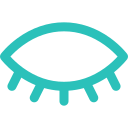Tips For Healthy Eyes
 Eye Test |
Having a routine comprehensive eye exam is the most important thing you can do to prevent or treat computer vision problems. If you haven’t had an eye exam in over a year, visit our store for free eye test! |
 Lighting |
When you use a computer, your ambient lighting should be about half as bright as that typically found in most offices. Also, if possible, position your computer screen so windows are to the side, instead of in front or behind it. |
 Glare |
Glare from light reflecting off walls and finished surfaces, as well as reflections on your computer screen also can cause computer eye strain. Consider installing an anti-glare screen on your display and, if possible, paint bright white walls a darker color with a matte finish. |
 Display |
Old-fashioned CRT screens can cause a noticeable “flicker” of images, which is a major cause of computer eye strain. Even if this flicker is imperceptible, it still can contribute to eye strain and fatigue during computer work. |
 Adjust |
Brightness: Adjust the brightness, text size, contrast and the color temperature. |
 Blink |
Blinking is very important when working at a computer; blinking moistens your eyes to prevent dryness and irritation. |
 20-20-20 Rule |
To reduce your risk of tiring your eyes by constantly focusing on your screen, look away from your computer at least every 20 minutes and gaze at a distant object (at least 20 feet away) for at least 20 seconds. |
 Take a break! |
Take frequent screen breaks during your work day (at least one 10-minute break every hour). During these breaks, stand up, move about and stretch your arms, legs, back, neck and shoulders to reduce tension and muscle fatigue. |
 Workstation |
Take frequent screen breaks during your work day (at least one 10-minute break every hour). During these breaks, stand up, move about and stretch your arms, legs, back, neck and shoulders to reduce tension and muscle fatigue. |
 Glasses |
Computer glasses also are a good choice if you wear bifocals or progressive lenses, because these lenses generally are not optimal for the distance to your computer screen. Also, you may want to consider photochromic lenses or lightly tinted lenses for computer eyewear to reduce your exposure to potentially harmful blue light emitted by digital devices. |
Food For Healthy Eyes
 Berries |
Berries are one of the highest food sources of antioxidants. They’re one of the healthiest foods for your eyes. The nutritious elements of berries could help prevent many disorders that eventually lead to impaired vision or blindness. |
 Nuts |
Nuts are also rich in omega-3 fatty acids. Nuts also contain a high level of vitamin E, which can protect the eye from age-related damage. Nuts like walnuts, cashews, peanuts, lentils etc are good for eye health. |
 Seeds |
Seeds are high in omega-3s and are a rich source of vitamin E. Seeds high in omega-3 include: chia seeds, flax seeds, hemp seeds. |
 Citrus Fruits |
Citrus fruits are rich in vitamin C. Vitamin C-rich citrus fruits include lemons, oranges, grapefruits. |
 Vegetables |
Leafy green vegetables are rich in both lutein and zeaxanthin and are also a good source of eye-friendly vitamin C. |
 Carrots |
Carrots are rich in both Vitamin A and beta carotene. Beta carotene gives carrots their orange color. Vitamin A plays an essential role in vision. It is a component of a protein called rhodopsin, which helps the retina to absorb light. |
 Sweet Potato |
Like carrots, sweet potatoes are rich in beta carotene. They are also a good source of the antioxidant vitamin E. |
 Water |
It may come as no surprise that a fluid essential to life is also vital to eye health. Drinking plenty of water can prevent dehydration, which may reduce the symptoms of dry eyes. |
